Workforce Tracking | Importance, Benefits, And Challenges
Workforce tracking is the systematic process of monitoring and recording various activities and performance metrics of employees within an organization.
It proves effective in small enterprises by providing a structured approach to monitoring and recording employee activities.
Whether it’s tracking attendance, monitoring work hours, or managing tasks, workforce tracking tools cater to the unique needs of smaller teams, fostering enhanced productivity and streamlined operations.
Small businesses often operate with limited resources, making efficiency and optimization paramount for success.
Top three issues workforce tracking solutions resolve for employers and employees are,
Accurate Attendance Management: Workforce tracking ensures precise attendance records, eliminating manual errors and promoting accountability.
Optimized Resource Allocation: Efficient workforce tracking aid in allocating resources effectively.
The resolution enhances project progress tracking, helping organizations optimize tasks and distribute workloads for increased productivity.
Compliance with Labor Laws: Small businesses often grapple with compliance issues related to labor laws.
Workforce tracking apps assist in navigating these complexities, ensuring adherence to regulations, mitigating risks, and safeguarding both employers and employees.
Try Buddy Punch For Free
| What Is Workforce Tracking? |
| Workforce tracking is a comprehensive management strategy involving continuous and systematic monitoring, analysis, and documentation of various aspects of employee activities and organisational performance. The strategic approach employs multiple tools and technologies to collect, process, and interpret employee behavior, work patterns, and output data. Workforce tracking is not just a set of tools; it’s a strategic initiative to leverage data to create a holistic view of the workforce, facilitating better decision-making. |
What Is Workforce Tracking In HR?
Workforce tracking in human resources (HR) is a strategic initiative that systematically monitors and analyzes employee activities to optimize HR processes.
In HR, workforce tracking utilizes tools and technologies to gather data on employee engagement, training progress, and overall productivity.
Practising this approach enables HR professionals to make informed decisions, enhance talent management, and ensure regulatory compliance.
What to Look for in an All-in-One Best Workforce Management Software Solution (WFM)?

An all-in-one best workforce management software is a comprehensive solution designed to address diverse HR management needs.
It integrates key features such as time & attendance tracking, leave management, shift scheduling, and performance management into a unified platform.
This human capital management (HCM) tool also caters to onboarding processes, providing a seamless user interface accessible through mobile devices.
The software’s self-service capabilities empower employees, facilitating tasks like shift swapping and PTO requests.
Ideal for various industries, including healthcare, the all-in-one workforce management solution ensures businesses can optimize work schedules, improve employee experience, and ultimately enhance overall profitability.
Does Workforce Management Software Include Time & Attendance Tracking?
Yes, workforce management software is designed to include robust time & attendance tracking as a fundamental feature.

This ensures accurate recording of work hours, aiding in payroll processing and compliance.
The best workforce management solutions utilize advanced time clock functionalities, often accessible through mobile devices.
Time & attendance tracking is essential for various industries, including healthcare, to monitor employee schedules and comply with regulations.
The software streamlines leave management and absence management processes, contributing to human capital management (HCM) goals.
By encompassing time & attendance tracking, workforce management software enhances overall operational efficiency, supporting businesses in adapting to changing work environments and improving employee experience.
Why Is Workforce Tracking Important For Businesses?
Workforce tracking significance lies in its ability to enhance workforce efficiency, foster compliance with labor laws, and facilitate data driven decision making.
Through tools like time tracking apps, businesses gain insights into productivity patterns, enabling better workload management and resource allocation.
Additionally, workforce tracking addresses challenges like payroll accuracy, project management precision, and adherence to compliance requirements.
How Does Workforce Tracking Help To Improve Employee Productivity?
Workforce tracking plays a pivotal role in enhancing employee productivity by providing insights, and accountability, and fostering efficient workflows.

With accurate tracking of work hours, tasks, and project timelines, employers gain a comprehensive view of individual and team performance.
Having such visibility allows for better resource allocation, identifying areas of improvement, and acknowledging high-performing employees.
Workforce tracking tools often include features like real-time monitoring, task management, and performance analytics.
This enables managers to address bottlenecks promptly, allocate tasks effectively, and make data-driven decisions.
Moreover, transparency in tracking promotes accountability among employees, encouraging them to meet deadlines and maintain consistent output.
By fostering a culture of accountability and optimizing resource allocation, workforce tracking contributes significantly to improved employee productivity, ultimately benefiting the overall efficiency and success of the organization.
What Technologies Are Commonly Used For Workforce Tracking?
In workforce tracking, various technologies play a crucial role in ensuring accurate monitoring and management.
Time tracking software stands out as a common and effective tool.
It enables employers to monitor employee activities, track time usage, and streamline project management.
Additionally, employee productivity tracking software offers internet and application usage monitoring features, providing valuable insights into time spent during work hours.
Advanced systems, including facial recognition, multi factor authentication, and GPS technology, contribute to secure and precise time tracking.
Furthermore, remote employee tracking software has become increasingly prevalent, allowing companies to seamlessly manage and monitor remote teams.
Does Workforce Tracking Help Improve Employee Accountability?
Yes, workforce tracking can significantly contribute to improving employee accountability.
By implementing workforce tracking tools and systems, organizations gain real-time insights into employee activities, projects, and time management.

This transparency fosters a culture of accountability as employees are aware that their performance is being monitored.
Workforce tracking enables managers to set clear expectations, monitor task progress, and identify potential bottlenecks.
It allows for the accurate measurement of individual and team productivity, facilitating objective performance evaluations.
Additionally, the visibility into time spent on tasks helps in identifying areas for improvement and optimizing workflows.
Moreover, workforce tracking systems often empower employees by providing them with data on their own performance metrics.
This self-awareness encourages individuals to take ownership of their tasks and deadlines, ultimately contributing to a more accountable and productive work environment.
Buddy Punch | Best Workforce Tracking Software
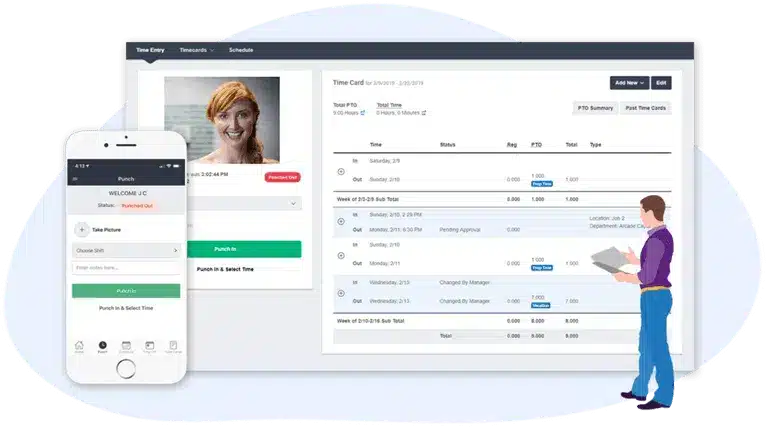
Buddy Punch is a premier workforce tracking software that businesses across diverse industries and sizes embrace.
Its user-friendly interface and versatility make it a solution for streamlined employee time tracking.
Businesses benefit from its automated features, reducing the errors and inefficiencies associated with manual tracking methods.
Unlike traditional systems, Buddy Punch offers real-time insights into employee attendance, time-off requests, and project tracking, fostering transparency and accountability.
Its cloud based accessibility allows seamless integration, making it more efficient than many alternatives.
1. Employee Time Tracking
Employee time tracking offered by Buddy Punch enables businesses to seamlessly monitor work hours during workdays, breaks, and overtime.

This functionality not only aids in payroll processing but also promotes transparency and accountability within the workforce.
With user friendly interfaces on both desktops (Windows and Mac) and mobile accessibility (Android and iOS), employees can easily clock in and out, fostering a convenient and efficient time management system.
2. Monitor Overtime
Buddy Punch offers robust overtime monitoring capabilities to help organizations effectively manage and track employee work hours beyond standard schedules.

The system enables employers to set customizable overtime rules based on labor regulations or company policies.
Through intuitive time tracking features, Buddy Punch monitors employee clock-ins and clock-outs, accurately calculating regular and overtime hours.
Supervisors and administrators can easily access real-time data on employee work hours, including any overtime incurred.
The system also provides overtime notifications and alerts when employees approach or exceed predetermined overtime thresholds, aiding proactive management.
Buddy Punch’s overtime monitoring enhances compliance with labor laws, prevents unauthorized overtime, and facilitates precise payroll processing.
The transparency provided by the system fosters accountability among employees, encouraging responsible time management.
With detailed overtime reports and analytics, organizations can make informed decisions, optimize workforce efficiency, and ensure fair compensation for overtime work.
3. Payroll Processing
Payroll processing streamlines and simplifies the intricate task of managing payroll.

With the ability to utilize job codes, run custom reports, and integrate seamlessly with various payroll software, Buddy Punch ensures an efficient and error-free payroll process.
The software’s commitment to flexibility is evident, offering diverse punch options, such as PINs, QR codes, facial recognition, and more.
Buddy Punch addresses the challenges of payroll accuracy and maximizes the benefits of time tracking, fostering a seamless and integrated approach to workforce management.
4. Notifications Alerts
Buddy Punch excels in providing real time notifications and ensuring managers stay informed about punches, pending time card approvals, and other critical updates.
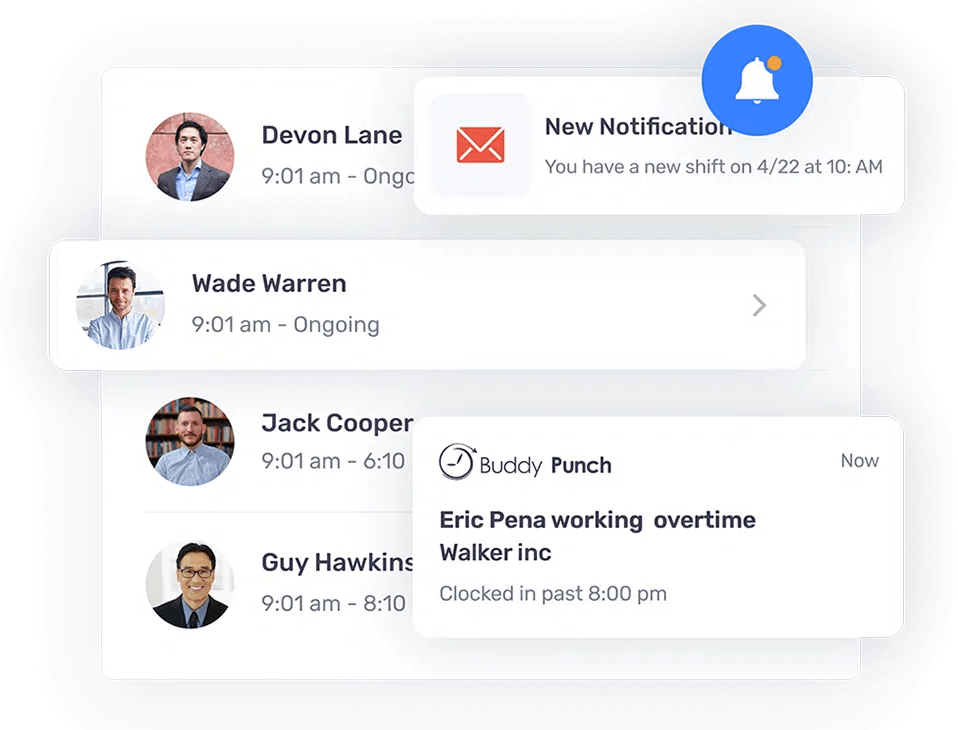
The software offers a customizable system, allowing managers to receive alerts through email or the mobile app, keeping them in the loop effortlessly.
The feature enhances communication and addresses the challenge of timely response in workforce management.
5. Customizable Reports
Buddy Punch empowers organizations with a robust reporting system, allowing users to tailor reports to meet their needs.
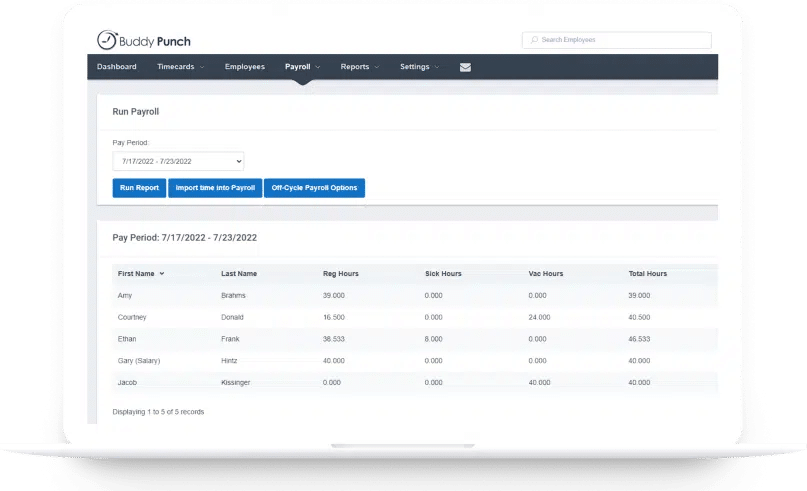
With diverse spreadsheet formats, including Excel and PDF export options, the software facilitates seamless integration with payroll providers.
The emphasis on customizable reporting enhances data management and addresses the challenge of extracting valuable insights from time tracking data.
Buddy Punch ensures that businesses can effortlessly navigate through a wealth of information, optimizing their decision making processes and reaping the benefits of a tailored, data driven approach to workforce management.
6. GPS Tracking
Buddy Punch harnesses the power of GPS technology to provide real time insights into employee locations during clock ins and clock outs.
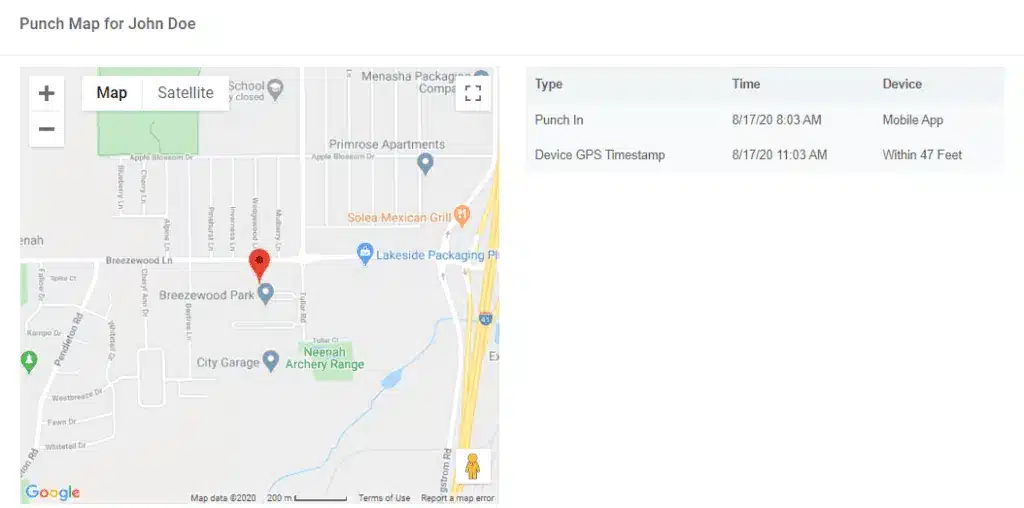
The feature enhances accountability and transparency, allowing organizations to monitor and verify work locations effectively.
Buddy Punch goes beyond conventional time tracking by addressing the challenge of ensuring remote employee accountability.
The benefits of GPS Tracking extend to improved workforce management, enabling businesses to optimize resources, enhance operational efficiency, and maintain a comprehensive view of their workforce’s spatial dynamics.
7. Text To Punch
Text to punch allows employees without a data connection to seamlessly punch in or out by sending a text message, eliminating the need for a dedicated app.

The feature exemplifies its dedication to accessibility, ensuring that all employees, regardless of connectivity constraints, can effortlessly record their work hours.
This innovation addresses the challenge of connectivity and underscores the software’s commitment to providing flexible and user friendly solutions in the ever evolving landscape of workforce management.
8. Integrations
Buddy Punch integrates with various providers, including QuickBooks, Paychex, and ADP, offering a synergistic approach to workforce management.
These integrations are pivotal in simplifying operational processes, reducing redundancies, and enhancing overall efficiency.

The commitment to integration streamlines workflows and addresses the challenge of managing diverse tools and platforms.
The software ensures a cohesive and integrated experience, allowing businesses to harness the full potential of their workforce tracking endeavors.
9. Geofences
Geofencing allows businesses to create specific areas where employees must clock in and out.
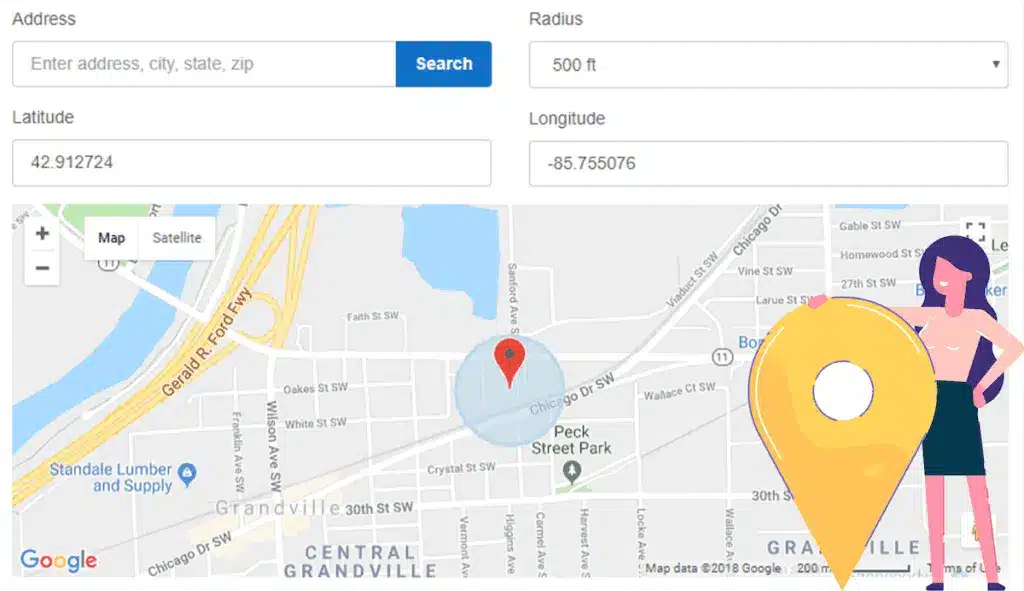
With the ability to assign multiple areas and unique job codes, Buddy Punch ensures accurate time tracking based on location.
The feature addresses the challenge of remote workforce management and exemplifies the software’s dedication to providing granular control over employee attendance.
By leveraging Geofences, organizations can enforce location specific punch restrictions, fostering accountability and optimizing workforce efficiency with a tailored, location centric approach.
How To Use Buddy Punch as a Workforce Tracking Software?
Managers can adeptly oversee employee work hours, pending time cards, and breaks utilizing web and app interfaces.
The platform ensures meticulous supervision and process streamlining, empowering users to address pending work hours or time card approvals expeditiously.
Here are a few Buddy Punch solutions you can explore on your own and see if Buddy Punch fits your business needs a workforce tracking tool.
- How to Take Action on Pending Work Hours—Manager (App)
- How to Manage Employee Work Hours—Manager (Web)
- How to Manage Employee Work Hours—Manager (App)
- How to Take Action on Pending Time Cards—Manager (App)
- How to Take Action on Pending Work Hours—Manager (Web)
- How to Manage Employee Breaks—Manager (Web/App)
- How to Take Action on Pending Time Cards—Manager (Web)
Buddy Punch’s Online Reviews
As of writing this blog post, Buddy Punch has a total of 925 total reviews with an average rating of 4.8 out of 5 on capterra.

“Great app, check in and out with accuracy, keep in contact with supervisors and can submit photos for proof of visit if not using GPS.”
Click here to read the full review.
“Delighted! As a trucking company and having resources starting their shifts at different times and in different locations it was “effort” in tying this all together to ensure everyone was being paid for correct times – doing payroll was a chore in calling and requesting and then finally imposing deadlines or you don’t get paid which pushes other things back in processing payroll… Week one of deployment -> all those issues disappeared!!! Well done Buddy Punch!!!!”
Click here to read the full review.
“We will always use Buddy Punch, It works for Us.”
Click here to read the full review.
Try Buddy Punch for Free
Ready to give Buddy Punch a try?
For free trial, no credit card required.
If you feel that Buddy Punch might be the right fit for your business, sign up for a 14-day free trial (no credit card needed). You can also book a one-on-one demo, or view a pre-recorded demo video.
Benefits Of Workforce Tracking For Small Businesses
The following are the benefits of workforce tracking.
1. Proper Time Management
By implementing a robust workforce tracking system, businesses can gain real-time insights into employee activities, ensuring optimal utilization of work hours.

These systems enable accurate tracking of tasks, project timelines, and individual productivity.
With precise data on time allocation, managers can identify inefficiencies, optimize workflows, and enhance overall productivity.
Proper time management through workforce tracking not only contributes to efficient task execution but also ensures that employees are engaged in meaningful and impactful work, aligning with organizational goals and boosting overall operational effectiveness.
2. Better Employee Productivity
By harnessing advanced tracking tools, organizations gain insights into employee activities, project timelines, and task completion.
The heightened visibility fosters a culture of accountability and empowers employees to optimize their work processes.
Workforce tracking facilitates the identification of productivity bottlenecks, allowing for targeted improvements.
With real-time monitoring, managers can offer timely support, allocate resources efficiently, and enhance overall productivity.
3. Accurate Payroll Calculations
Workforce tracking systems, such as Buddy Punch, play a pivotal role in ensuring precise payroll calculations.

By capturing real-time data on employee work hours, overtime, and attendance, these tools eliminate manual errors and streamline the payroll process.
Accurate time tracking provides a reliable foundation for payroll departments, minimizing discrepancies and reducing the risk of payroll-related issues.
With automated features and comprehensive reporting, businesses can confidently generate payroll, adhere to labor regulations, and ensure that employees are fairly compensated for their time and efforts.
The result is not just efficiency but also enhanced trust and satisfaction among the workforce.
4. Legal Protection for both Employees and Employers
Accurate time and attendance records generated by tracking systems serve as crucial documentation in case of labor disputes or audits.
For employees, it ensures fair compensation and guards against potential wage disputes, while employers benefit from compliance with labor regulations.
By maintaining precise records, organizations can demonstrate adherence to overtime policies and protect against legal challenges.
Workforce tracking not only fosters transparency in labor practices but also establishes a foundation for legal compliance, creating a secure environment for both employees and employers.
5. Workforce Accountability
By implementing robust workforce tracking system, you empower employees to take ownership of their tasks and responsibilities.
Real-time visibility into work activities fosters a culture of responsibility, ensuring that individuals are mindful of their performance and deadlines.
Accountability is further strengthened through accurate monitoring of work hours, task progress, and project milestones.
Workforce tracking tools, such as Buddy Punch, provide the insights needed to align individual efforts with organizational goals, promoting a sense of responsibility among team members and contributing to a more accountable and productive work environment.
6. Identification Of Training Needs
By analyzing employee performance and productivity metrics, organizations can pinpoint areas requiring skill development or additional training.
Workforce tracking systems provide valuable insights into specific tasks, projects, or processes where employees may benefit from further training.
Having this proactive approach not only ensures that employees are equipped with the necessary skills for their roles but also contributes to overall workforce development, fostering continuous improvement and adaptability in a rapidly evolving business landscape.
7. Seamless Monitoring Of Remote Teams
When it comes to flexible work arrangements, the benefits of workforce tracking extend to seamlessly monitoring remote teams.
Workforce tracking tools, like Buddy Punch, empower organizations to effortlessly oversee the productivity and activities of dispersed teams, whether they are on-site or working remotely.
This workforce management system utilizes automation to streamline workforce management processes, offering features such as on-site biometric time clock options for enhanced security and accuracy.
Through real-time insights into tasks, projects, and time allocation, businesses can ensure remote employees stay on track with their responsibilities.
The system not only helps in preventing time theft but also provides valuable data for efficient workforce productivity analysis.
For job sites that require on-site presence, Buddy Punch’s biometric options enhance security and ensure accurate attendance records, addressing concerns related to on-site workforce management.
Moreover, with the ability to run payroll seamlessly, this workforce management tool contributes to job site retention by fostering transparent and efficient payroll processes.
This is particularly crucial for businesses managing a blend of on-site and remote workers.
The comprehensive set of workforce management tools provided by Buddy Punch enhances the overall efficiency and retention strategies of organizations with diverse work arrangements, promoting a harmonious balance between on-site and remote work dynamics.
Ready to start a free trial?
No credit card required, all features included.
8. Cost Reduction
By closely monitoring employee activities, businesses can identify areas of inefficiency, streamline workflows, and optimize resource allocation.
Time tracking enables accurate labor cost calculations, helping businesses stay within budget and avoid unnecessary expenses.
Additionally, workforce tracking tools often automate processes, reducing the need for manual intervention and minimizing errors.
Through improved productivity insights, organizations can make informed decisions on staffing levels, project allocation, and resource utilization, ultimately contributing to significant cost reduction and enhanced financial efficiency.
9. Data-Driven Decision Making
By meticulously capturing employee performance metrics, task progress, and project timelines, businesses gain deep insights into operational efficiency.
Following this data-driven approach enables managers to identify trends, forecast future needs, and optimize resource allocation.
It ensures strategic decision-making based on real-time analytics, fostering a proactive and adaptive work environment.
With precise information on work patterns and productivity, businesses can implement targeted improvements, enhance overall performance, and align workforce strategies with organizational goals.
What Challenges Might Arise When Implementing a Workforce Tracking Solution?
The following are the challenges that arise when implementing a workforce tracking solution.
1. Privacy Concerns
When integrating a workforce tracking solution, organizations may encounter challenges, with one prominent concern being privacy issues.

Employees may express apprehension about their privacy being compromised due to constant monitoring.
To address this challenge effectively, employers should communicate transparently about the purpose and scope of the tracking system, emphasizing its role in optimizing workflow and not as a means of intrusive surveillance.
Implementing clear policies and guidelines, ensuring data security measures, and obtaining informed consent can help strike a balance between workforce tracking benefits and addressing privacy concerns.
2. Employee Resistance
Employees might resist the tracking system, fearing increased surveillance and micromanagement.
The resistance can stem from concerns about privacy invasion, a perceived lack of trust, or unease about being constantly monitored.
To mitigate employee resistance, employers need to communicate transparently about the purpose and benefits of the tracking system.
Involving employees in the decision making process, addressing their concerns, and emphasizing the system’s positive impact on overall efficiency are vital strategies to foster acceptance and cooperation while implementing a workforce tracking solution.
3. Data Security
Workforce tracking involves collecting and storing sensitive data, making it a potential target for cyber threats.
Employers must prioritize robust security measures, including encryption protocols, access controls, and regular system audits, to ensure the confidentiality and integrity of the collected data.
By investing in advanced security measures, organizations can enhance the overall effectiveness of their workforce tracking solution while maintaining the integrity and security of the data involved.
4. Integration With The Existing System
Integrating a tracking system into established frameworks can be complex, requiring careful planning and seamless execution.
Compatibility issues, data migration concerns, and disruptions to current operations are common challenges organizations may face during integration.
To navigate this challenge effectively, businesses should thoroughly assess their current systems, identify potential integration points, and invest in solutions that offer flexibility and compatibility.
5. Legal and Regulatory Compliance
Businesses must navigate the challenge of legal and regulatory compliance, particularly considering that different regions may have specific regulations regarding employee monitoring.

Ensuring adherence to these regulations is paramount to avoid legal consequences and maintain ethical workplace practices.
Businesses should comprehensively review local and national laws governing employee monitoring, addressing aspects such as data privacy, consent, and the extent of permissible monitoring.
Is Employee Scheduling Included In Workforce Tracking?
Employee scheduling is a crucial aspect of workforce management.
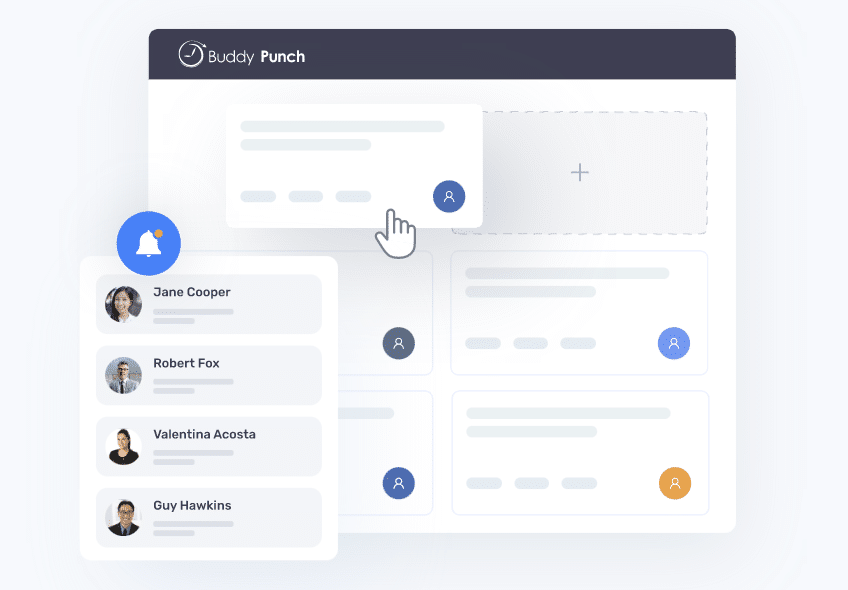
The best workforce management software integrates robust scheduling tools to optimize work schedules efficiently.
This includes shift scheduling, swapping, and self-service options for employees.
The user interface is designed for seamless navigation, enabling managers to create, modify, and communicate work schedules effortlessly.
The software considers factors such as employee availability, skill sets, and compliance with labor laws.
By incorporating scheduling into workforce tracking, businesses can enhance employee experience, ensuring staff is appropriately allocated, thereby improving overall productivity and profitability.
Ready to start a free trial?
No credit card required, all features included.
How Do Timesheets Play a Role In Workforce Tracking?
Timesheets are integral to workforce tracking as they capture crucial data related to employee work hours.
A key feature of any workforce management solution, timesheets enable accurate time and attendance tracking.
The best workforce management software incorporates user-friendly timesheets accessible via mobile devices.
This facilitates onboarding and ensures that the workforce management solution aligns with HR management needs, including leave and absence management.
Timesheets, as part of the broader workforce tracking strategy, contribute to efficient payroll processing, compliance, and overall operational excellence.